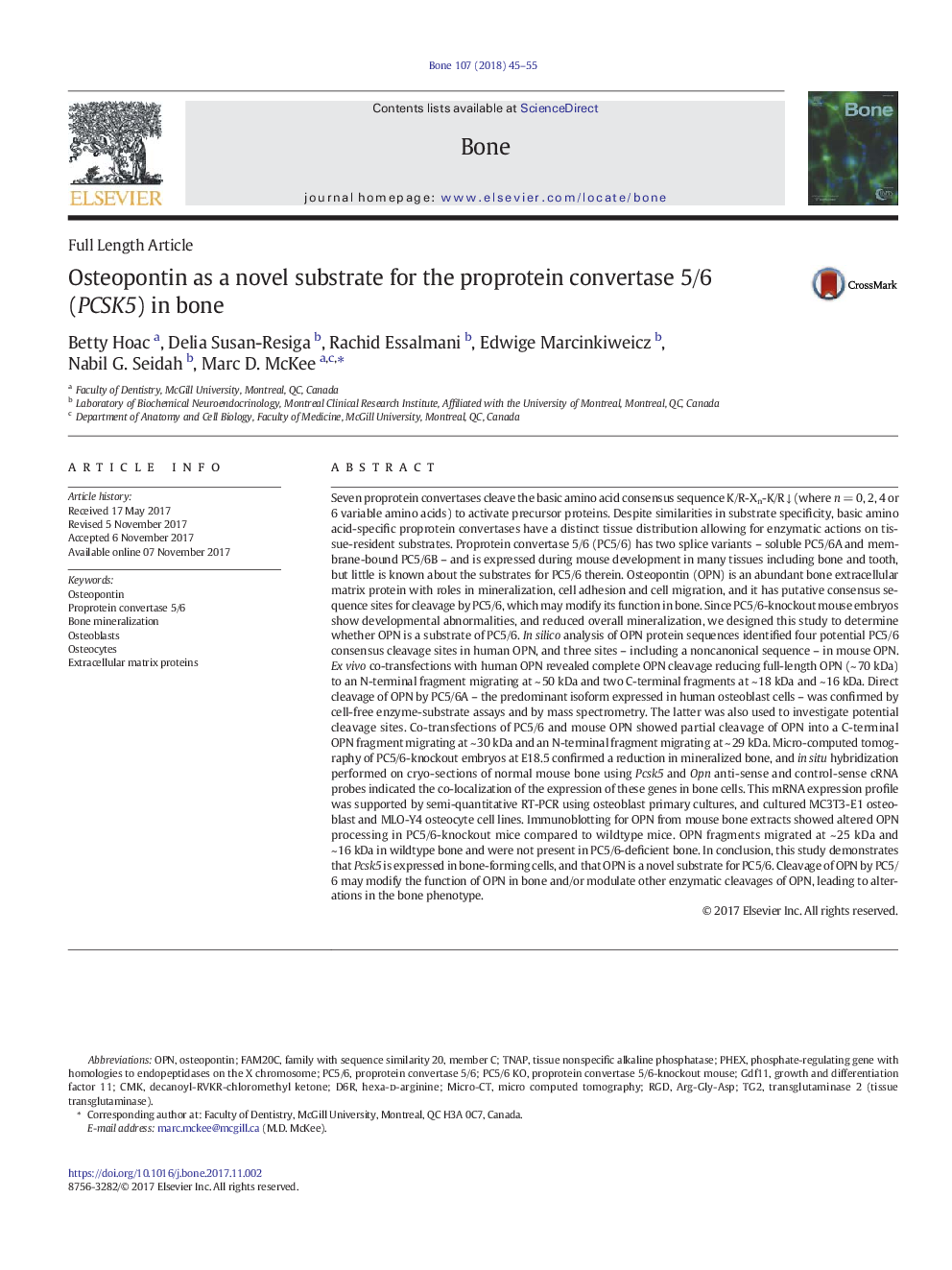| کد مقاله | کد نشریه | سال انتشار | مقاله انگلیسی | نسخه تمام متن |
|---|---|---|---|---|
| 8625173 | 1568112 | 2018 | 11 صفحه PDF | دانلود رایگان |
عنوان انگلیسی مقاله ISI
Osteopontin as a novel substrate for the proprotein convertase 5/6 (PCSK5) in bone
دانلود مقاله + سفارش ترجمه
دانلود مقاله ISI انگلیسی
رایگان برای ایرانیان
کلمات کلیدی
TG2Tissue nonspecific alkaline phosphataseGDF11Arg-Gly-AspPHEXFAM20CCMKTNAPOPNRGDOsteoblasts - استئوبلاست هاOsteocytes - استئوسیت هاOsteopontin - استئوپنتینBone mineralization - استخراج کانی سازیMicro-CT - میکرو CTmicro computed tomography - میکروسکوپ الکترونیExtracellular matrix proteins - پروتئین ماتریکس غیر سلولی
موضوعات مرتبط
علوم زیستی و بیوفناوری
بیوشیمی، ژنتیک و زیست شناسی مولکولی
زیست شناسی تکاملی
پیش نمایش صفحه اول مقاله

چکیده انگلیسی
Seven proprotein convertases cleave the basic amino acid consensus sequence K/R-Xn-K/R â (where n = 0, 2, 4 or 6 variable amino acids) to activate precursor proteins. Despite similarities in substrate specificity, basic amino acid-specific proprotein convertases have a distinct tissue distribution allowing for enzymatic actions on tissue-resident substrates. Proprotein convertase 5/6 (PC5/6) has two splice variants - soluble PC5/6A and membrane-bound PC5/6B - and is expressed during mouse development in many tissues including bone and tooth, but little is known about the substrates for PC5/6 therein. Osteopontin (OPN) is an abundant bone extracellular matrix protein with roles in mineralization, cell adhesion and cell migration, and it has putative consensus sequence sites for cleavage by PC5/6, which may modify its function in bone. Since PC5/6-knockout mouse embryos show developmental abnormalities, and reduced overall mineralization, we designed this study to determine whether OPN is a substrate of PC5/6. In silico analysis of OPN protein sequences identified four potential PC5/6 consensus cleavage sites in human OPN, and three sites - including a noncanonical sequence - in mouse OPN. Ex vivo co-transfections with human OPN revealed complete OPN cleavage reducing full-length OPN (~ 70 kDa) to an N-terminal fragment migrating at ~ 50 kDa and two C-terminal fragments at ~ 18 kDa and ~ 16 kDa. Direct cleavage of OPN by PC5/6A - the predominant isoform expressed in human osteoblast cells - was confirmed by cell-free enzyme-substrate assays and by mass spectrometry. The latter was also used to investigate potential cleavage sites. Co-transfections of PC5/6 and mouse OPN showed partial cleavage of OPN into a C-terminal OPN fragment migrating at ~ 30 kDa and an N-terminal fragment migrating at ~ 29 kDa. Micro-computed tomography of PC5/6-knockout embryos at E18.5 confirmed a reduction in mineralized bone, and in situ hybridization performed on cryo-sections of normal mouse bone using Pcsk5 and Opn anti-sense and control-sense cRNA probes indicated the co-localization of the expression of these genes in bone cells. This mRNA expression profile was supported by semi-quantitative RT-PCR using osteoblast primary cultures, and cultured MC3T3-E1 osteoblast and MLO-Y4 osteocyte cell lines. Immunoblotting for OPN from mouse bone extracts showed altered OPN processing in PC5/6-knockout mice compared to wildtype mice. OPN fragments migrated at ~ 25 kDa and ~ 16 kDa in wildtype bone and were not present in PC5/6-deficient bone. In conclusion, this study demonstrates that Pcsk5 is expressed in bone-forming cells, and that OPN is a novel substrate for PC5/6. Cleavage of OPN by PC5/6 may modify the function of OPN in bone and/or modulate other enzymatic cleavages of OPN, leading to alterations in the bone phenotype.
ناشر
Database: Elsevier - ScienceDirect (ساینس دایرکت)
Journal: Bone - Volume 107, February 2018, Pages 45-55
Journal: Bone - Volume 107, February 2018, Pages 45-55
نویسندگان
Betty Hoac, Delia Susan-Resiga, Rachid Essalmani, Edwige Marcinkiweicz, Nabil G. Seidah, Marc D. McKee,